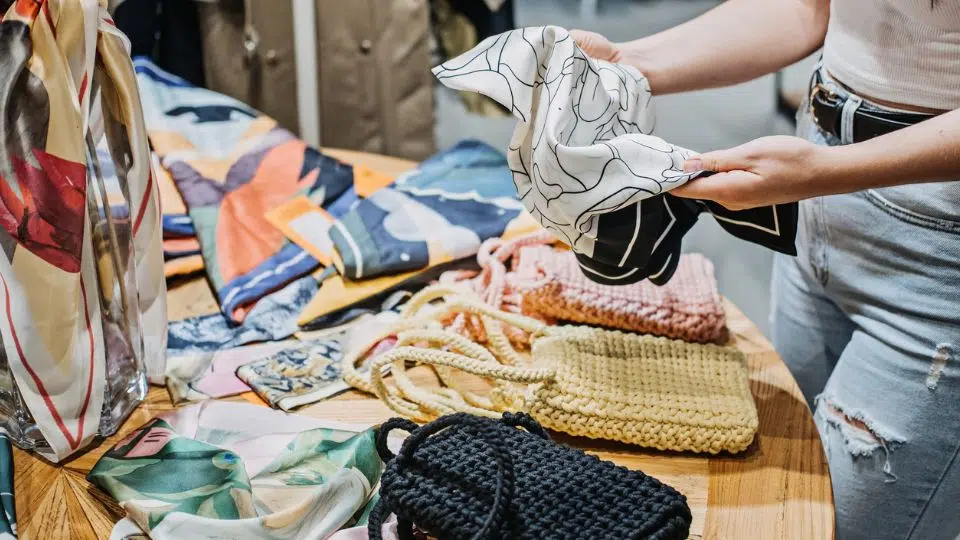By Heather Koerner

What was once relegated to the depths of the return’s box or the landfill, pre-purchased merchandise is now celebrated as the new circular fashion for responsible citizens. Who knew pre-owned goods would amount to an estimated $350 billion by 2027 worldwide with 92% of US consumers shopping or trading second hand last year alone? Indeed, reuse, repurpose, recycle, rental, resell has not only become a global trend, but a legitimate retail initiative.
EVERYBODY SEEMS TO BE DOING IT
You could have counted the number of retailers entering this space on one hand not long ago, but now the list is like the who’s who in the industry. From expected brands like REI and Patagonia, to heritage brands like Levi’s and Carhartt, fast fashion’s H&M and Zara, mall mainstays like The Gap, J. Crew, PacSun, Abercrombie & Fitch, aspirational niche brands like Canada Goose and Lululemon, accessories and home furnishing retailers such as Kate Spade and Ikea, mass retailers such as Target and TJX, sports brands like Dicks, modern brands like Free People, Urban Outfitters and even newer names like Everlane and Vuori are tossing their prior worn/used goods into the proverbial reuse pot. Luxury brands, too, are entering this space as highly sought after and vintage items have found a new home with the next generation owner. The emergence of resale platforms, too, has expanded with the growth of the industry and consumer demand. The likes of Poshmark, ThredUp, Depop, Vestiaire Collective, The Gilt Group, The Real Real, Recurate and more are trying to quench the thirst for, dare we say, “hand-me-down” goods.
WE KNOW THE NUMBERS
The more we know about waste and its impact on the environment, the more we are seeking ways to right our wrongs. Fashion, in particular, has the lofty label of contributing 10% of all human-related carbon emissions and 20% of all industrial water pollution. Sadly, even with all of the fashion developments and trends, 85% of all textiles still make it to the dump each year and the industry still produces 100 billion estimated pieces every year. That’s why retailers are now getting clever. Perhaps it was driven by consumer trend, perhaps it was for purely altruistic purposes, perhaps it was ignited by supply chain bottlenecks, but resale entered its own over the last few years. Brands like IKEA and their AS IS resale shop in shop have become a case study and a role model for retailers looking to blend marketing, customer experience and channel profitability.
At a 2023 NRF NY session, the IKEA team shared that by 2030 they want to be climate positive and that this goal is being partially driven by their resale initiatives. They have found that resale not only drives store traffic and increases frequency, but that it increases customer basket size and, per other industry stats, is driving higher consumer lifetime values (2.5x ROI). And while their research showed that 74% of shoppers were motivated by price to shop the AS IS merchandise, 47% were in it for the actual merchandise selection, 35% for the fun and 30% to be more environmentally conscious. The key question remains on how, if at all, resale can be profitable. In the case of IKEA, the answer is yes. They saw a 218% increase from June -December the last 7 months of the buyback program (in buyback stores). They also posted an overall 4.0+ decrease in their carbon footprint and posted a +6.5% increase in sales. A win-win-win.
SO, WHAT’S THE CATCH?
Any good idea is wrought with issues and resale is no different. What may seem like a no-brainer, is actually a complex business initiative that requires a cross-functional team to assess and solve for an array of challenges. Five of the primary areas that require scrutiny are:
- LOGISTICS/OPERATIONS
- TRAINING
- DISTRIBUTION
- MERCHANDISING/PRICING
- FINANCES
None of these areas are easily solved for and vary by product type and retailer type. What works for fashion may not work for books or accessories or furniture and vice versa. Specifically, brands need to first define why they want to implement a buyback and resale program (for brand, for culture, for profit) and then figure out the general logistics and operations involved in doing so. High level, brands need to assess whether or not they need stores to execute such a program or if they can do this via digital/mail processing. They need to determine if they have the right systems in place to flow goods, identify, inventory, track. They need to define how they will accept goods, how they will assess them, clean/refurbish them and how to allow for the incremental time employees are spending on the program.
The latter point leads to a much larger conversation on resource allocation and employee training. Most of merchandise assessment can be qualitative and subjective. Under what lens do you evaluate the viability of a buyback product? What are the standards? Who decides?
Once a product is brought back into an assortment and assuming the retailer can flow the item through their system and assign a new SKU, the overall distribution strategy must be addressed. Will the resale program live only online or only in store. And if it is only store-based, is it a regional program? How do you determine what locations, how frequently do you flow product and ultimately where do you put it on the selling floor?
This now leads to the dialogue around merchandising. Unless there is a run on a single item within a season, retailers will most likely be dealing with one-off items, a single SKU/Color/Size. How can you present a compelling story around random buyback items and, equally important, at what price do you offer such items? What are your customer expectations and what are they willing to pay for second-hand goods? Are you prepared to offer 20%, 30% or even 40% off and how do you assign pricing based on wear and tear? And, again, who and how are you making these decisions? Even if the merchandise is presented online only, only 13% of brands are actually integrating used products into site search. How are you considering the user experience in the digital space?
All of these considerations feed into the overall financial economics. How can retailers plan season over season and year over year and build a buyback/resale program into their quarterly plans? Also, can customers return a buyback item? What does this program do to labor planning and four wall profit for the designated stores? Should buyback stores have allowances? What does the displaced merchandise sales loss look like to dedicate a resale shop-in-shop? And how do you account for the refurbishment and reprocessing of the items?
Perhaps all of these challenges are why partnership opportunities with third party resellers is a path forward. Working with the earlier mentioned platforms that manage the intake and resale of products for brands allow retailers to test and learn while they enter the circular space. While there are additional margin implications involved, the amount of removed obstacles may prove to be advantageous. That said, there is a whole other conversation that is happening about the success and profitability of the platforms themselves who, even with increased adoption, are facing losses. Most likely as a result of all of the concerns outlined herein.
WHAT’S NEXT AND WHAT NOW?
While it may seem obvious to point out all that can go wrong or that needs to be considered in a buyback market model, the reality is that consumers are driving a need to figure it all out. Whether retailers move forward with a resale platform partner or decide to go digital or regionally physical with their programs, there is truly a place in their business mix for recommerce. Some brands are implementing repair stations in their stores to extend the longevity of their products (and increase customer store trips in return). Others are adopting selective merchandise recommerce models that work as extensions of their brands (like used books or only accessories or vintage one-of-a-kind pieces). While still others are rethinking the program to include store credit or rebates (like Lush’s $1 pot return program).
Regardless of your approach, the underlying elements of your success will rely on your preparedness and readiness. Not just with products, processes and people, but with your retail systems as well. Legacy systems can present obstacles to adapt to new methods of retail. Evaluating your ERP, merchandise planning, forecasting, POS, warehouse management and supply chain systems are the one common thread to moving forward and defining what is next for your brand in this space. Like everything else, sometimes embracing the future requires taking a step back.
Recommerce maybe dominating the news in 2023, much like the supply chain in 2021 and inflation in 2022, but one thing is constant, retailers will find a way forward and the consumers will be leading the way.
Note: Various statistics referenced in this article came from Retail Dive 4/5/23, Retail Dive 4/17/23, ELLE Magazine April 2023, WWD and industry research and direct presentations at NRF 2023.
ABOUT COLUMBUS CONSULTING
Columbus Consulting is a leading retail consulting firm. Our team of retail consulting practitioners all have career experience with leading global brands in retail, CPG, wholesale, and grocery. Our philosophy is simple, if you do it, we do it. From strategy through implementation, our retail consultants will work as extensions of your team. For over 20 years, we have helped companies like yours with assortment planning, inventory planning, demand planning, unified commerce consulting, store systems consulting, FP&A consulting, IT consulting, data analytics consulting, digital transformation and more. With a 96% re-engagement rate, our retail consultants pride themselves on building long-term, trusting relationships by being nimble and driving true value.
ABOUT HEATHER KOERNER
Heather Koerner is an omni-channel expert with a deep knowledge in merchandising and planning. She is a former Chief Merchandising Officer and has transformed how retailers go to market, increasing speed and introducing the accuracy of data-driven decision making into the process. Heather is currently a Principal at Columbus Consulting International and brings her breadth of retail industry knowledge to help transform her clients with her category and product leadership skills.
